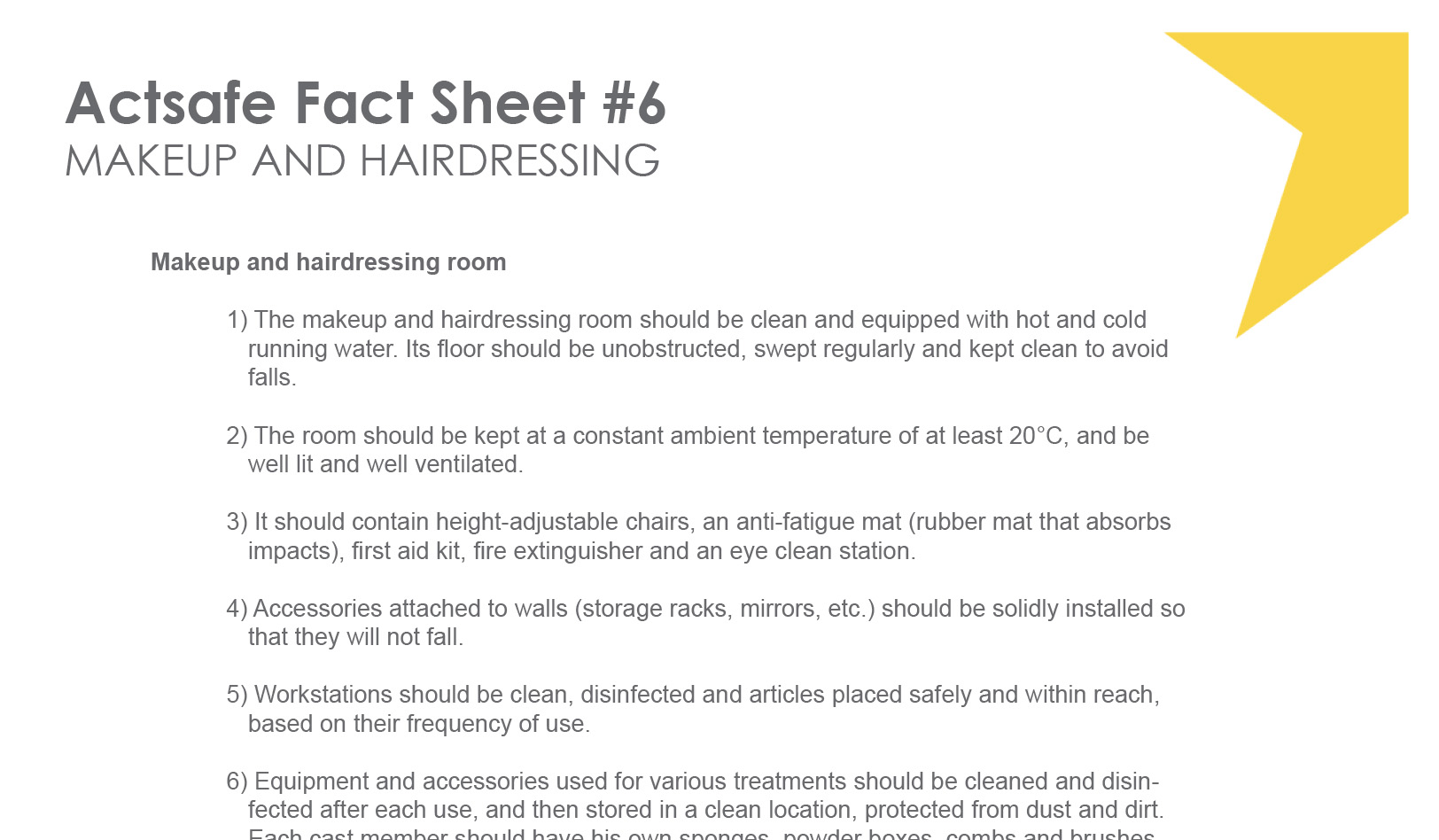This fact sheet provides safety information on makeup and hairdressing products and practices used in the motion picture, television, performing arts and live events industries.
Makeup and hairdressing room
- The makeup and hairdressing room should be clean and equipped with hot and cold running water. Its floor should be unobstructed, swept regularly and kept clean to avoid falls.
- The room should be kept at a constant ambient temperature of at least 20°C, and be well lit and well ventilated.
- It should contain height-adjustable chairs, an anti-fatigue mat (rubber mat that absorbs impacts), first aid kit, fire extinguisher and an eye clean station.
- Accessories attached to walls (storage racks, mirrors, etc.) should be solidly installed so that they will not fall.
- Workstations should be clean, disinfected and articles placed safely and within reach, based on their frequency of use.
- Equipment and accessories used for various treatments should be cleaned and disinfected after each use, and then stored in a clean location, protected from dust and dirt. Each cast member should have his own sponges, powder boxes, combs and brushes. On the set, these articles should be kept in clearly labeled plastic bags. No double dipping.
- The cast hairdressers and makeup artists should use a cart or ask the technical team for help in carrying heavy or bulky equipment. To maintain good back posture, they should properly distribute the weight of the equipment to be carried for touch-ups (eg., use a belt, or a jacket with several pockets, a shoulder bag, etc.).
- The production should provide them with seats for sitting during waiting periods and allow them to take full advantage of break and meal periods, due to long working hours.
Safe use of products
- Cast hairdressers and makeup artists must:
- obtain information from suppliers about the possible risks and side-effects of certain hairdressing or makeup products;
- keep a list of the products used, indicating, among other things, the purchase date;
- check with the cast regarding allergies or sensitivities to certain products (you may do a small patch test). If someone reacts to a product, use of the product must be immediately stopped, and the first aid attendant, producer or safety coordinator must be informed;
- follow general hygiene rules such as washing hands before and after each hair or makeup application.
- When applying dye or colouring or when perming or straightening hair, appropriate gloves must be worn and the ventilation must be adequate. As much as possible, avoid using sprays; otherwise, avoid being in the spray cone, limit the time of use, and use a face shield to protect the cast member.
- Products must be kept at the proper temperature, and flammable liquids and aerosols kept in a cool place, away from sources of heat and flame. The manufacturer’s recommendations about the product’s use and storage must be followed.
- Controlled substances decanted from the original container into another container must be labeled.
- The following are mandatory:
- use one tube of mascara per person to avoid infection;
- immediately replace outdated products;
- use containers with dispensers for liquid products;
- preferably use products in gel or cream form and avoid powders that have to be mixed;
- use a disinfected spatula to remove a product from its container (never use your fingers).
Chemicals
- Maintain an inventory of products used.
- Research the ingredients of these products to identify any potential health hazards (pay particular attention to routes of entry and dermal irritation).
- Clearly label all chemicals.
- Have Material Safety Data Sheets (MSDS) for each toxic chemical available for the user. When involved in potentially hazardous activities such as the application of colours, hairsprays, mixing powder bleaches and oxidizing chemicals, appropriate protective equipment such as face masks, goggles, gloves, etc., should be worn.
- Wherever possible use non-aerosol hairsprays.
- Wherever possible use premixed powders.
- When using an air brushing system, adequate ventilation is required.
Actor’s Personal Makeup Bag
An actor’s personal makeup bag, should contain the following:
- Clean makeup bag
- Individual powder compact with powder puff, brush, sponge etc.
- Individual palette
- Individual eye drops
- Individual brushes
- Individual nail file
Cleaners
- Cleaners should be kept clean by decanting small amounts into a separate container and be discarded when contaminated.
- Use cleaning products in well ventilated area.
Specific Brush Cleaners: Parian Spirit, Naimes, Cinema Secrets for cleaning makeup brushes
99% Isopropyl Alcohol: For cleaning makeup out of brushes, palettes, spatulas, surfaces etc.
70% Isopropyl Alcohol: For brushes and tools. Soak in 70% alcohol for 5 minutes to disinfect.



Share Now: